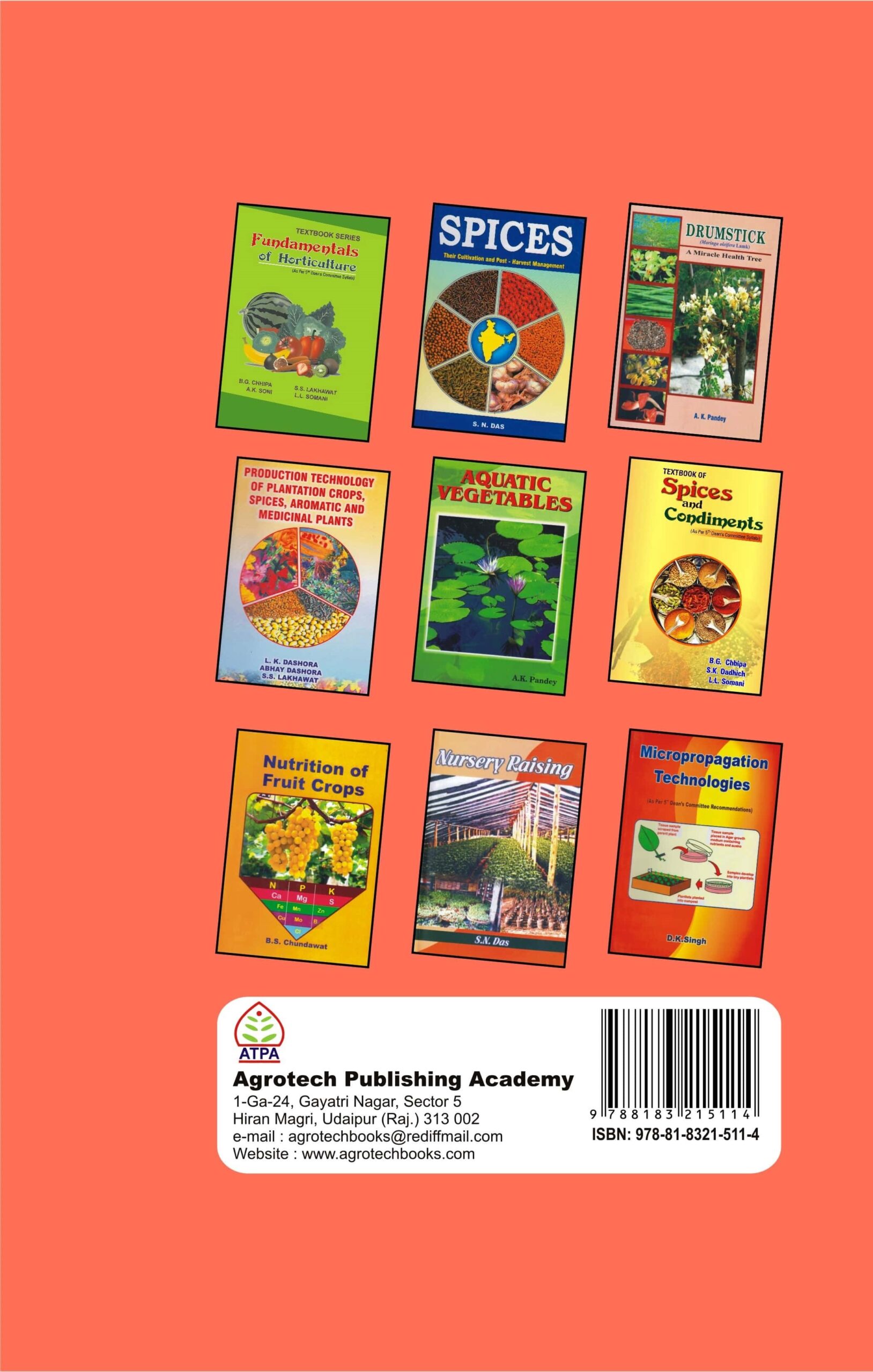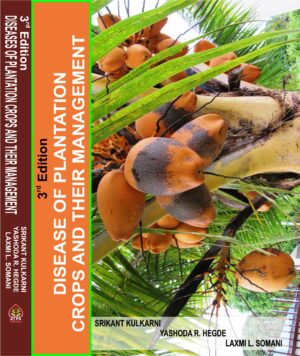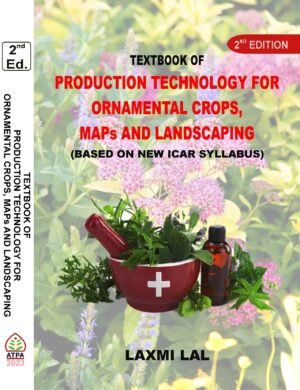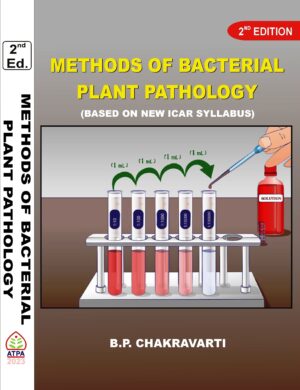HANDBOOK ON MEDICINAL PLANTS
₹2,500.00 ₹1,250.00
REPRINTED: 2023
AUTHORS: A.B. SHARANGI, KALKAME CH MOMIN AND S. KUNDU
PUBLISHING YEAR: 2020
ISBN: 9788183215114
© All Rights Reserved
Description
ABOUT THE BOOK
During ancient period, the knowledge and names of medicinal plants were spread through folk songs, folk tales, symbols, stone inscriptions,etc. The ancient civilizations like Indian, Greek, Mesopotamian, Babylonian, Egyptian, Chinese, Inca and Maya of South America had their epic, classical literature, Materia-Medica, etc., where a good number of plants were mentioned. Most of them were economic plants of medicinal value and play an important role in modern medicine.
Medicinal plants are distributed across India in her unique agro-climatic and bio-geographic regions, diverse habitats and vast landscapes. Around 70% of India’s medicinal plants are found in the tropical areas and around 30% in the temperate and alpine areas. World Health Organization (WHO) has estimated that approximately 80% of the world population still relies on traditional medicines, which are mostly phyto-drugs. About 2,700 plants species are reported to be used in the codified Indian Systems of Medicine viz. Ayurveda (1800 species), Siddha (500 species), Unani (400 species) and Amchi (300 species). The renewed global interest in complementary and alternative systems is increasing the demand of plant-based Ayurvedic, Siddha and Unani (ASU) drugs. But the scientific and advanced aghrotechniques for growing the medicinal plants are still lacking. Most of the cases people follow the traditional age-old practices of cultivation, processing and storage of raw materials leading to reduced contents of active principles from the finished products.
This book has been designed to highlight the complex but compelling issues of medicinal plants, their botany, major uses, Agrotechniques, active principles present and specialized process of their extraction, in a nutshell. This handbook is also packed with much other information on medicinal plants alongwith a glossary of medical terminologies at the end. Hope the book will go a long way in catering scholastic services and rewards to diverse mights and professions including UG, PG and PhD scholars, teachers, amateur growers and many related stakeholders at large.
CONTENT
| S. No | Content | Page No |
| Foreword | 3-4 | |
| Preface | 5 | |
| About The Authors | 6-8 | |
| About The Book | 9 | |
| Chapter | ||
| 1 | Chapter One: Introduction | 13-19 |
| 2 | Chapter Two: Classification | 20-33 |
| 3 | Chapter Three: Production Technology | 34-277 |
| 3.1 | Field Mint or Corn Mint (Mentha arvensis) | 34 |
| 3.2 | Peppermint (Mentha piperita) | 38 |
| 3.3 | Sweet Basil (Ocimum basilicum) | 41 |
| 3.4 | Clove Basil or Lemon Basil
(Ocimum gratissimum) |
44 |
| 3.5 | Sacred Basil (Ocimum sanctum) | 47 |
| 3.6. | Kulekhara,Gokshur or Indian Cuckoo (Hygrophila auriculata) | 51 |
| 7.3. | Basak or Malabar nut tree
(Adhatoda vasica) |
54 |
| 3.8. | Muktajhuri or Indian Nettle
(Acalypha indica) |
57 |
| 3.9. | Dudhia or Snake weed or Asthma Plant (Euphorbia hirta) | 60 |
| 3.10. | Aonla or Indian Gooseberry
(Phyllanthus emblica) |
63 |
| 3.11. | Hurricane weed or stonebreaker (Phyllanthus amarus) | 68 |
| 3.12. | Devils Horsewhip (Achyranthes aspera L). | 71 |
| 3.13. | Kantanote or Spiny Pigweed
(Amaranthus spinosus L.) |
74 |
| 3.14. | Chattim or Devil’s Tree
(Alstonia scholaris L.) |
78 |
| 3.15. | Periwinkle (Catharanthus roseus) | 81 |
| 3.16. | Kurchi (Holarrhena antidysenterica) | 86 |
| 3.17. | Sarphaganda or Indian Snakeroot (Rauvolfia serpentina) | 89 |
| 3.18. | Bach or Sweet Flag (Acorus calamus L.) | 93 |
| 3.19. | Gurmar or Small Indian Ipecacuanha (Gymnema sylvestre) | 96 |
| 3.20. | Antamool or Indian Ipecacuanha
(Tylophora indica) |
99 |
| 3.21. | Karu or Himalayan gentian
(Gentiana kurroo) |
102 |
| 3.22. | Chirata or White Chirata (Swertia chirayita) | 106 |
| 3.23. | Thankuni or Indian Pennywort
(Centella asiatica L.) |
110 |
| 3.24. | Jatamanshi or Tagar (Valeriana jatamansi) | 114 |
| 3.25. | Nishinda or Monk’s pepper (Vitex negundo) | 117 |
| 3.26. | Anantamul or Indian Sarsaparilla (Hemidesmus indicus) | 121 |
| 3.27. | Gulancha or Heart leaved Moonseed plant or Giloe (Tinospora cordifolia) | 125 |
| 3.28. | Punarnaba or Pigweed or Hogweed (Boerhavia diffusa) | 129 |
| 3.29. | Shalpani or Shaparni
(Desmodium gangeticum) |
132 |
| 3.30. | Babchi or Lata kasturi (Psoralea corylifolia) | 135 |
| 3.31. | Pan or Betle leaf (Piper betel) | 139 |
| 3.32. | Brahmi or Herb of grace (Bacopa monnieri) | 143 |
| 3.33. | Kutki (Picrorhiza kurroa) | 147 |
| 3.34. | Ulatkambal or Devil’s Cotton
(Abroma augusta) |
151 |
| 3.35. | Kuchila or Crow Fig or Poison Nut (Strychnos nux-vomica) | 155 |
| 3.36. | Choi or Java long pepper (Piper chaba) | 158 |
| 3.37. | Kabab chini or Cubeb or tailed pepper (Piper cubeba) | 161 |
| 3.38. | Golmorich, Peppercorn, Black pepper
(Piper nigrum) |
164 |
| 3.39. | Ipecac or Ipecacuanha
(Cephaelis ipecacuanha) |
168 |
| 3.40. | Titbegun or Kantakari or Thorny nightshade (Solanum surattense) | 171 |
| 3.41. | Aswagandha or Indian ginseng
(Withania somnifera) |
174 |
| 3.42. | Kulanjan or Greater Galangal
(Alpinia galangal) |
177 |
| 3.43. | Dudhi (Euphorbia prostrata) | 181 |
| 3.44. | Mahua or Honey tree or butter tree (Madhuca longifolia) | 184 |
| 3.45. | Belladonna or Devil’s Cherries
(Atropa belladonna) |
189 |
| 3.46. | Safed Datura or Thorn apple
(Datura innoxia) |
194 |
| 3.47. | Downey Datura (Datura metel ) | 197 |
| 3.48. | Dhutra or Jimson weed
(Datura stramonium) |
200 |
| 3.49. | American or Nightshade
(Nicotiana tabacum) |
202 |
| 3.50. | Kakmachi or Black Nightshade
(Solanum nigrum) |
206 |
| 3.51. | Agar or Agarwood (Aquilaria malaccensis) | 209 |
| 3.52. | Gandhabena or Lemon grass
(Cymbopogon citratus) |
215 |
| 3.53. | Somlata, Joint pine or Jointfir
(Ephedra gerardiana) |
218 |
| 3.54. | Birmi, Talish Patra or Himalayan Yew (Taxus wallichiana) | 221 |
| 3.55. | Paathar chur, Pashan bhedi or Coleus (Coleus forskohlii) | 225 |
| 3.56. | Bhui khajur or Golden stargrass or Hyssop (Hyssopus officinalis) | 228 |
| 3.57. | Guggul or Indian Bdellium tree (Commiphora mukul) | 232 |
| 3.58. | Dronapushpi or Gumma (Leucas aspera) | 236 |
| 3.59. | Iswarmul or Worm killer
(Aristolochia bracteata) |
241 |
| 3.60. | White poppy (Papaver somnifera) | 244 |
| 3.61. | Akolshi, Cattle’s bean or Cowage
(Mucuna pruriens) |
248 |
| 3.62. | Isabgul, Psyllium or Indian plantago (Plantago ovata) | 252 |
| 3.63. | Glory lily or Languli
(Gloriosa superba Linn) |
255 |
| 3.64. | Senna or Indian Senna or Suvarnapatri (Cassia angustifolia Vahl.) | 259 |
| 3.65. | Honey leaf or Madhupatra
(Stevia rebaudiana Bert.) |
262 |
| 3.66. | Yam or Banalu or Ratalu (Dioscorea bulbifera Linn.) | 266 |
| 3.67. | Kalmegh or King of Bitters (Andrographis paniculata) (Burm.f.) Wall. ex Nees | 269 |
| 3.68. | Safed Musli or Indian spider plant (Chlorophytum borivilianum) | 273 |
| 4 | Chapter Four: Improved varieties | 278-288 |
| 5 | Chapter Five: Future prospects and strategies | 289-292 |
| 6 | Bibliography | 293-294 |
| 7 | Photographs of some medicinal plants | 295-300 |
ABOUT THE AUTHORS
Dr. A. B. Sharangi is one of the Professors of eminence in Horticulture and former Head, Department of Plantation, Spices, Medicinal and Crops, Faculty of Horticulture, Bidhan Chandra Krishi Viswavidyalaya (Agricultural University), India. He is in the profession of teaching for more than twenty years and instrumental in the process. He spent times in Prof. Cousen’s lab in Melbourne, Prof Picha’s lab in USA, Dr Dobson’s lab in UK and continued research on herbs and spices. One of his papers has ranked among the top 25 articles in ScienceDirect. He has published about 75 research papers in peer-reviewed journal, 50 conference papers, 20 books from reputed publishers including SPRINGER as well as several book chapters published from SPRINGER, Tailor and Francis, CRC Press, Nova Publishers (USA) and scores of popular scientific articles. Presently he is associated with 50 international and national journals as editor in chief, regional editor, technical editor, editorial board member and reviewer. Prof Sharangi has visited abroad extensively on academic mission and obtained several international awards viz., ENDEAVOUR Post-doctoral Award (Australia), INSA-RSE Visiting Scientist (UK), FULBRIGHT Visiting Faculty (USA), Achiever’s Award (SADHNA), Marquis Who’s Who (USA), Man of the Year-2015 (Cambridge, UK), Outstanding Scientist and Higher Education Leadership Award(Venus International Foundation), etc. He has delivered a couple of invited lectures in UK, USA, Australia, Thailand, Israel and Bangladesh on several aspects of herbs and spices. Prof Sharangi is associated with a number of research projects as Principal and Co-Principal Investigators having academic and empirical implications. He is an elected FELLOW of WB Academy of Science and Technology, (FAScT). He is also the Fellow of International Society for Research and Development (FISRD, UK), the Society of Applied Biotechnology (FSAB), Academy of Environment & Life Sciences (FAELS), International Scientific Research Organization for Science, Engineering and Technology (FISROSET), Scientific Society of Advanced Research & Social Change (FSSARSC), Society of Pharmacognosy and Phytochemistry (FSPP). He is an active member of several science academies and societies like NASI, NABS, ISNS, HSI, CWSS, SAH including the New York Academy of Science (NYAS), World Academy of Science, Engineering and Technology (WASET), to name a few.
Dr.Kalkame Ch. Momin has completed her B.Sc. (Agri) from Assam Agricultural University, Jorhat, Assam; M.Sc Agri. (Horti) from Dr Panjabrao DeshmukhKrishi Vidyapeeth, Akola, Maharashtra and Ph.D Floriculture and Landscaping from Dr.Yashwant Singh Parmar University of Horticulture and Forestry, Nauni, Solan (H.P). She has been awarded the ICAR-NET in Horticulture in the year 2010. She worked as a Guest Lecturer in the Department of Horticulture, North Eastern Hill Universityfrom 2013 to 2016 and is presently working as Assistant Professor in the Department of Floriculture and Landscaping Architecture, College of Horticulture and Forestry, Pasighat, Arunachal Pradesh under Central Agricultural University. She is a recipient of Dr.Panjabrao Deshmukh Birth Centenary Gold Medal, Barrister Sheshrao Wankhade Gold Medal, Shri Madhao Gangadhar Bhumralkar Cash Prize, Annasaheb Mahajani Cash Prize for being the university topper in M.Sc. Agri. (Horti) in the year 2009 conferred by Dr Panjabrao Deshmukh Krishi Vidyapeeth, Akola, Maharashtra. She has been awarded INSPIRE fellowship by DBT, Government of India during her Ph.D programme. Dr.Momin has over 10 research publications, book chapters and has presented papers in international, national workshops, seminars and symposiums. She is a life member of two professional scientific soceities of India.
Dr. S. K. Kundu has M.Sc. in Botany (Genetics and Plant Breeding) from Kalyani University and PhD degree in Genetics from Bidhan Chandra Krishi Viswavidyalaya, in the year 2000. After submission of Thesis, he was engaged in a Central Sector Scheme on medicinal plants as a research associate. He further joined as a Post Doctoral fellow in a Research project “Inventorising the medicinal plants resources in India “sponsored by DBT, Govt. of India, in the reputed research Institute Botanical Survey of India, Howrah, West Bengal. He has two years teaching experience in a college. He has published 10 research papers in different journal. He has participated in many workshops and seminars in and national level. Presently he has engaged himself as a P.G. Teacher of Biological science in a heritage school. He was established a medicinal Garden named ‘Charak Uddyan’ in the school campus.
Additional information
| AUTHOR/AUTHORS | A. B. SHARANGI, KALKAME CH MOMIN, S. KUNDU |
|---|---|
| PAGES | 300 |
| BINDING | Hard Back |
| PUBLICATION YEAR | 2020 |
Related products
-
- Sale!
DISEASES OF PLANTATION CROPS AND THEIR MANAGEMENT
-
₹2,500.00₹1,250.00
-
- Sale!
TEXTBOOK OF PRODUCTION TECHNOLOGY FOR ORNAMENTAL CROPS, MAPs AND LANDSCAPING
-
₹2,500.00₹1,250.00
-
- Sale!
METHODS OF BACTERIAL PLANT PATHOLOGY
-
₹1,980.00₹990.00





